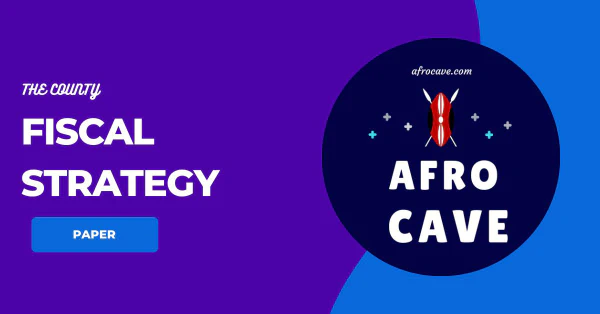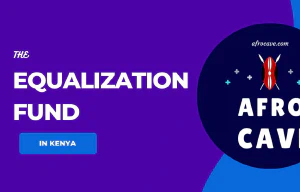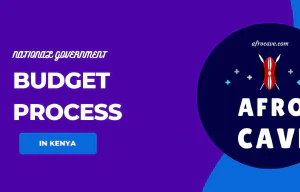What is the County Fiscal Strategy Paper in Kenya?
- Author Gĩthĩnji
- Updated on:

The County Fiscal Strategy Paper in Kenya is the guide to the county budget process. It looks at how the past and the present setting of the budget process can inform the future.
Therefore, it is important to learn how to analyse a County Fiscal Strategy Paper.
The County Fiscal Strategy Paper (CFSP) shall specify the broad strategic priorities and policy goals that will guide the county government in preparing its budget for the coming financial year and over the medium term (3-5 years).
Every County Treasury shall prepare and submit the County Fiscal Strategy Paper to the County Executive Committee for approval. The County Treasury shall then submit the approved Fiscal Strategy Paper to the County Assembly by 28th February of each year.
The County Treasury must publish and publicize the Fiscal Strategy Paper within seven days after it has been submitted to the County Assembly (By 7th March). This allows the public to engage with the document and submit their proposals, either in forums organised by the county government or through written submissions (memoranda, et cetera).
For the purpose of understanding the County Fiscal Strategy Paper, we shall use the Nairobi County’s draft County Fiscal Strategy Paper 2019.
Table of ContentsShow/Hide
analysing a County Fiscal Strategy Paper
There are four crucial components that are important to analysing the County Fiscal Strategy Paper:
- Performance,
- Priorities,
- Projections, and
- Ceilings.
The key components are usually summarised as the “three Ps and one C”. Let’s discuss them in detail below.
Performance
The performance section provides up-to-date information on county government expenditure and revenue collection. It helps to determine whether the decisions made going forward on revenue collection and expenditure are realistic.
The performance is usually sector-based. For example, how much is the county spending on health in relation to agriculture? Or else, how much revenue has the county been able to raise? A person shall pinpoint this information from the Fiscal Strategy Paper.
County governments shall base their up-to-date budget performance on the previous financial year and the recent budget implementation reports. The recent budget reports are usually the half-year performance reports produced during the 2nd quarter of the current financial year (July to December).
In the Draft County Fiscal Strategy Paper 2019 for Nairobi County, the performance information is provided in pages 14-24.
Projections
The second key aspect of the County Fiscal Strategy Paper is projections. The projections shall indicate the overall revenue and expenditure expected for the next (or coming) budget year. They shall also indicate any deficit expected in the budget.
The County Fiscal Strategy Paper shall indicate how much revenue the county government expects to raise from the central government and from its own local revenue sources. It shall also indicate the expected revenue from donor funding, grants, and internal or external borrowing in the next budget year.
For expenditure, the projections shall show items like recurrent expenditure, capital or development expenditure, debt repayment, among others.
The figures provided when coming up with the projected revenue and expenditure shall be reasonable. This is because some counties design ambitious budgets that they are unable to keep up with. Others provide figures that lead to rundown budget levels.
The information on performance serves as the baseline for projecting revenue and expenditure in the next financial year. That is, looking at the past and present budget performance to inform the future (projections).
The projections in the draft Nairobi County County Fiscal Strategy Paper 2019 are in Annex I on page 80.
Priorities
Priorities in the County Fiscal Strategy Paper deal with identifying what to fund or the distribution of needs across sectors. This involves identifying priority spending areas.
This section identifies key priorities and the areas to receive less funding so that the priorities can receive more. This shall also reflect in the figures provided in the sector ceilings (see below on ceilings).
Priorities explain the choices made in the next financial year for the various sectors. For example, why is the county government prioritising agriculture over early childhood development?
From there, you shall match priority sectors to the figures in the sector ceilings. The narrative in the priorities shall correlate to the figures in the ceilings.
The budget priorities in the draft Nairobi County Fiscal Strategy Paper 2019 are in Chapter 4.
Ceilings
The sector ceilings represent the budget limits. They determine the amount of money allocated to each sector and how the money is distributed across these sectors.
The ceilings shall show the amount of money the counties will spend on meeting the identified priorities. This section involves identifying the numbers, the sector allocations, that are the core of every Fiscal Strategy Paper.
You shall be able to identify the areas getting the highest and the lowest allocations from this section.
As noted earlier, the ceilings shall correlate with the priority spending areas. The figures provided in the budget ceilings shall match with the narrative under priorities.
For example, if a county says that it will prioritize health (in the priority section), then the budget allocation (or ceilings) shall be increased as compared to the previous financial year or even relative across sectors.
The Sector Ceilings in the Nairobi Draft County Fiscal Strategy Paper 2019 are in Annex II on page 81.
The County Fiscal Strategy Paper is important in that, once these sector ceilings are set, they are final. Therefore, it is important for the public to participate in the preparation of their County’s Fiscal Strategy Paper. The budget estimates rely on these ceilings when the estimates are tabled before the County Assembly on April 30.
This means that the budget ceilings set for sectors such as health, agriculture and environment are what appear in the budget estimates, unless the County Assembly approves changes to the ceilings in the budget estimates.
For example, if KES 4 billion is allocated for health in the County Fiscal Strategy Paper, that’s the amount that shall appear in the budget estimates (unless amended by thr Assembly). The budget estimates breakdown the ceilings further into programmes and subprogrammes (and even projects in some cases).
Therefore, if you want your sector of choice to be given priority, then you shall negotiate this at the sector level when the County Fiscal Strategy Paper is out for public participation.
In practice, when analysing a County Fiscal Strategy Paper, the performance, projections, and ceilings shall be provided in table format because they represent figures. The priorities shall be in a narrative form since they explain the choices made in the sector ceilings.
Public participation
Does the County Fiscal Strategy Paper recognize public input? To prove this, there shall be a list of factors affecting the final allocations. This is referred to as the risk section.
An example of this at the national (government) level of budgeting is on page 108-126 of the National Budget Policy Statement 2019.
The County Fiscal Strategy Paper shall include a similar risk section.
Miscellaneous
It is also worthy to reiterate that the County Fiscal Strategy Paper estimates expenditure and revenue for the coming financial year and the subsequent two years (the medium-term). A financial year in Kenya begins in July of the current year and ends in June of the coming year.
When drafting the County Fiscal Strategy Paper, every county shall align it with its national equivalent, the National Budget Policy Statement (BPS). IBP Kenya has a guide on how to analyse the BPS.
The period leading to the formulation of the County Fiscal Strategy Paper allows the public to bargain on what they consider most important to them in any financial year. It is a haggling and negotiation process.
I hope you have gained important tips on analysing the County Fiscal Strategy Paper for your county government.
- «Previous The Process to Impeach a Deputy Governor in Kenya
- Next» Budgeting Process for the National Government in Kenya


